I would like to introduce Fushimi Inari Shrine, one of Kyoto’s leading landscapes.
This is the second introduction. I will introduce the entrance to the mysterious Fushimi Inari mountain trail. We can pass through the precincts of the main shrine, pass through Senbon Torii, Shinike, and Mitsutsuji to reach Yotsutsuji.
Please see below for the first introduction of Fushimi Inari.
- Torii from the precincts to the inner shrine
- A shrine where five gods are enshrined together
- Ryogu-sha
- Tamayama-sha
- Shinme-sha
- Byakko-sha Okumiya
- Senbon torii entrance ( thousand torii gate )
- Oku no in
- Omo karu Ishi ( Omokaru stone )
- Ema of Oku no In (picture of your wish)
- Fushimi inari guide map
- Approach to the north from Okunoin
- The road of Shinpo-shrine
- Shinpo-Shrine ( 伏見神寳神社 )
- Kanae-bina (wish Doll)
- Neagari no Matsu (Pine roots are exposed on the ground)
- Approach from Okunoin
- Three-way intersection to Okunoin Kumataka-sha
- Approach to Kumataka-sha
- Kumataka -sha mound ( stone tower )
- Shin-ike (Kodama-ga-ike)
- Kumataka-sha
- Approach from Kumataka-sha to Mitsutsuji
- Mitsu-tsuji
- Mitama-tei
- Kyo-ya, Enoki-sya
- hyo-tei
- Daimatsu-sha
- Santoku-tei, Santoku-sha
- Distant view from in front of Yotsu-tsuji
- Stairs to Yotsu-tsuji
- Your good actions can keep Kyoto beautiful.
Torii from the precincts to the inner shrine
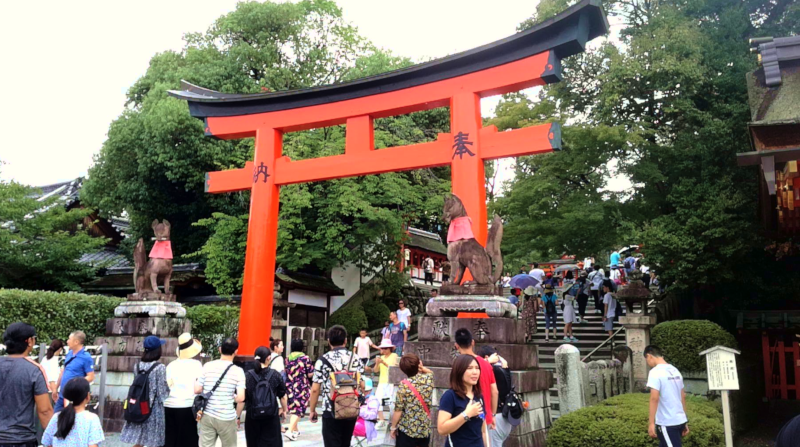
Go through the torii gate at the back of the main shrine of Fushimi Inari-taisha and you will be out of the precincts. In the back is the entrance to Inari Taisha Shrine, the Senbon Torii (thousand torii gate) corridor and Mt. Inari.

When you pass through the torii gate, the small shrine of Fushimi Inari Taisha is celebrated on the left side.
You can find the deities associated with Fushimi Inari Taisha Shrine.
Left side : Choja-sha festival god Hata (former shrine) Sojin
Right side: Kada-sha, Festival God, Mr. Kada (former shrine)
The priests of Fushimi Inari Taisha include the families of Hata and Kada.
In the mountain tours introduced later, you will find these Choja-sha and Kada-sha. However, you can visit these shrines so close without having to go around the inari mountains.
A shrine where five gods are enshrined together
Here is the small shrine behind the main hall.

The name of five gods.
Yebisu-sha [Kotoshiro Nuishi no kami]
Takeo-sha [Susano no ookai]
Jakuoji-sha [Jakuoji no ookami]
Hiyoshi-sha [Oyamakui no Kami]
Hachimangu-sha [Ojin tennou]
A famous god that we have heard somewhere is worshiped as the last shrine of Fushimi Inari-taisha.A shrine where five gods are enshrined together
Ryogu-sha

The god of the festival: Emperor Amaterasu , Toyouke kodaijin(outer shrine of Ise).
The highest deities of Japan are enshrined in the inner and outer shrines of Ise Shrine.
It is said that the relationship with Inari God is deep.
Tamayama-sha
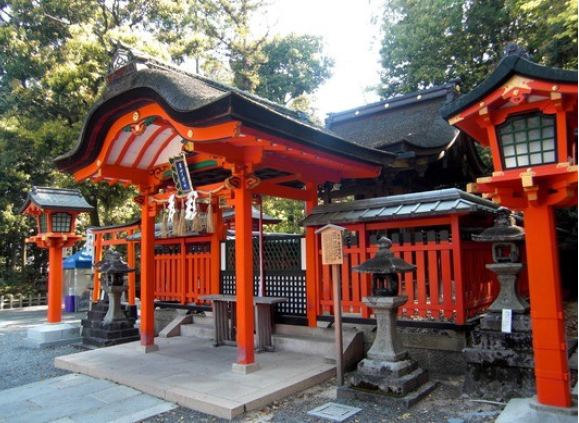
Pass by the Gonden and the shrine, go up the stairs to the end of the shrine, and you can see Yushan Shrine in front.
Originally there was Oku-no-miya, but it was relocated to a different location during the Genroku period.
Tamayama Inari-Okami was enshrined here instead. Tamayama Inari-Okami was enlisted in the Imperial Palace and was enshrined in the Imperial Palace in Kyoto, but was relocated to its current location in 1873.
Shinme-sha

God’s horse is worshiped in Shinme-sha.

Byakko-sha Okumiya
You can find Byakko-sha on the left front of the stairs.
The god of the festival is the goddess of the prostitute, Myobu no Kami.
The Myobu mean that the name of a middle-class woman who came in and out of the palace during the Heian period.
Eventually, he began to call the shrine maiden who served Inari Taisha Shrine, and in the Middle Ages came to mean the Inari fox.
At Inari Taisha Shrine, you can see foxes all over you, telling us the word of God and nature’s providence. And we believe they will help our lives.

“Okumiya” is next to the Byakko-sha.
The worshiped god is “Inari Okami”.
The three gods are enshrined in the same row and were built at the same time as the main shrine. Okumiya is so called because it is deep inside the main hall.
It is said to be a venerable shrine with three shrines on the top of Mt. Inari. Because this shrine worships the same god as the main shrine, and there are three worshiped gods.
Senbon torii entrance ( thousand torii gate )

There is an entrance of “Senbon Torii” beside okumiya.
Senbon Torii is a passage to okunoin in myobudani. The meaning of “Senbon torii” is thousand torii gates, and as the name implies, there are many torii gates, and the torii gates are vermilion, so the entire field of view is vermilion corridor.
Its mysterious and beautiful scenery is unique, and it is a popular spot for Japanese and foreign tourists.

The vermilion corridor is divided into two branches on the way, both of which lead to Okunoin.
When going to Okunoin from the entrance, pass on the left side. On the other hand, when going down from okunoin, pass on the right side. That is, we should always keep to the left in the direction we are going.
This is the manner of Fushimi Inari, so you should follow it!
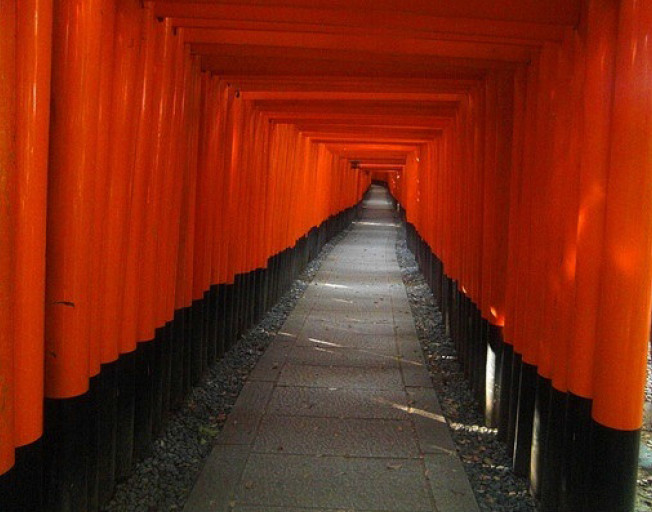
The corridor continues to the vanishing point of your way. This landscape is the true value of Senbon Torii, which is unique to Fushimi Inari. You will fall into the illusion of a vermilion infinite corridor that will last forever. At night the lights are on and the corridor is lit up.
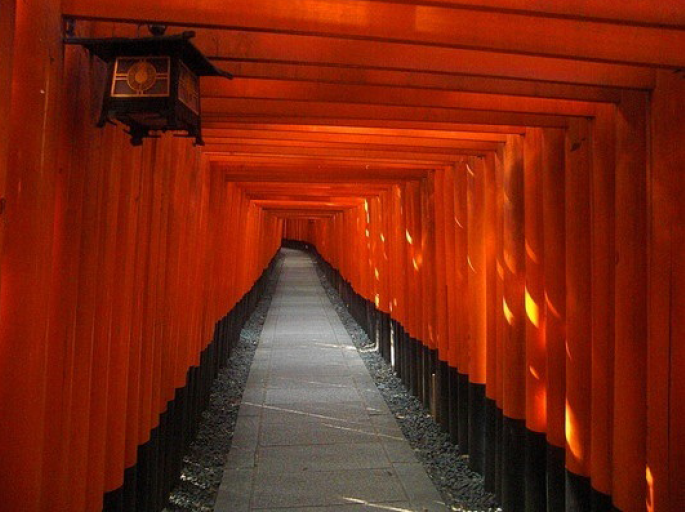
Vermilion is said to avoid the evil.
By passing through this vermilion torii corridor, the vermilion torii will avoid the evil of your heart before you reach the Okunoin.
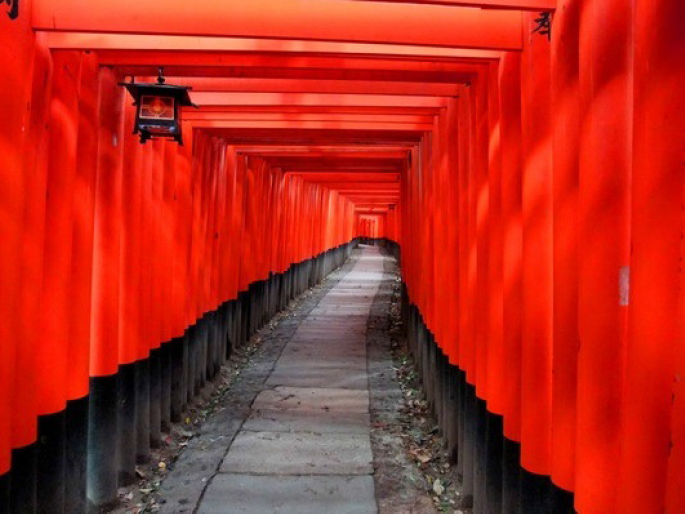
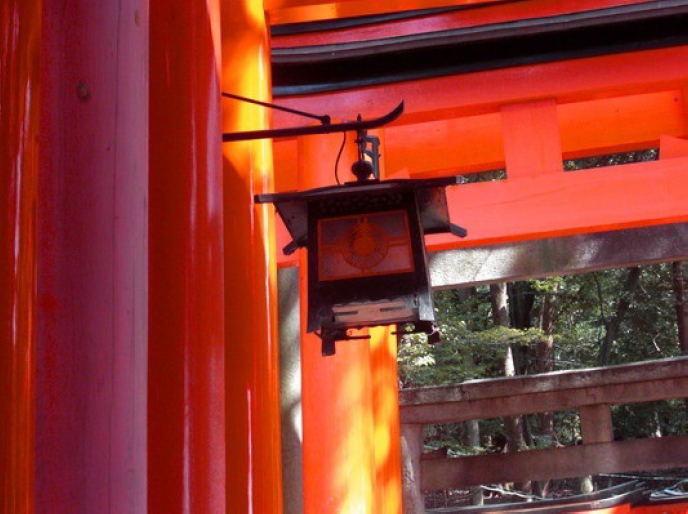

Looking at the back of the torii, you can find the name and address of the person or company that dedicated the torii, and the date of the offering.
You can find addresses not only in Kansai, but also in many prefectures throughout Japan. In addition, there seems to be many dedicated torii gates recently.
The price of the torii can be found on the website of Fushimi Inari Shrine. A small torii costs over 170,000 yen and a large torii costs over 1.3 million yen.
You can see clearly that the interests of the god of business prosperity are attained throughout Japan.

Oku no in

After passing through the “Senbon Torii”, you will arrive at Oku-sha, commonly known as “Oku-no-in”.
Because this area is called “Myobudani”, the Okunoin is also called “Myobu-sha”.
“Myobu” mean a female government official who serves the palace, and is another name for the fox, the angel of the Inari god. Japanese people worship the mountain of nature as a god.
Behind the worship hall there is a main shrine, and behind it is a torii gate that worships the whole Mt. Inari as a god.
Here it has the same effect as visiting the three peaks of Mt. Inari.

Omo karu Ishi ( Omokaru stone )

There is a stone lantern called “Okaru Stone” at the back right of Okunoin.
When you lift the ” Okaru Stone “, your wish will come true if the stone is lighter than you expected . On the other hand, it is said that if the stone is heavier than you expected, your wish will not come true.
Ema of Oku no In (picture of your wish)

Normal emas are square or pentagonal, but Fushimi Inari sells emas with fox faces.
You can dedicate your wishes and the fox’s expression. There seems to be a lot of unique writing in it.
Fushimi inari guide map

This is a map of Mt. Inari.
The mountain trail at Mt. Inari takes 4km to complete a round trip and takes 2 hours.
There is also up and down, so going around the mountain will give you a lot of exercise.
Some people go jogging every morning.

This is an old map of Mt. Inari in 2013.
Approach to the north from Okunoin
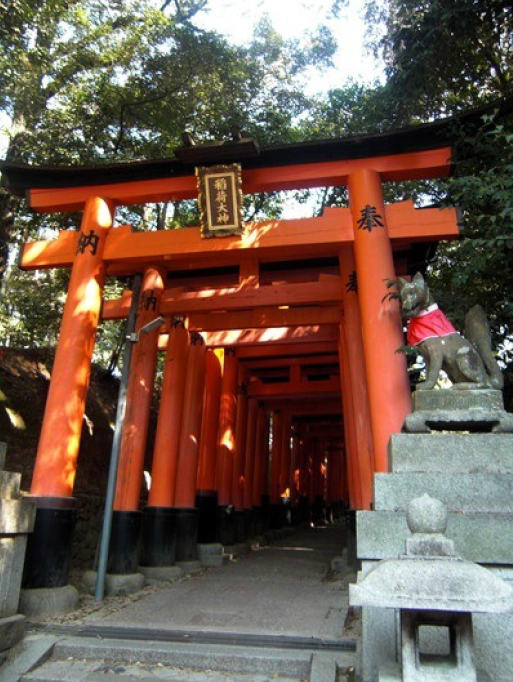
The torii corridor is still extending.
From here onwards is the trail course at Mt. Inari.
The distance is about 4 km, the altitude of the summit is 233 m, and the course takes 2 hours, so not many people go further.
However, it can be said that the true value of Fushimi Inari.
From here, the world of Mt. Inari is slightly different from before. This Myobu-dani(Valley) is the starting point of the mountain trail.
The road of Shinpo-shrine

If you take a sidewalk from the approach to the torii gate, you will be connected to an old road called Takenoshita-michi.
It is said to be Yamatoji which was connected to Yamato in old times.
The atmosphere surrounded by bamboo grove seems to be outside the barrier of the torii gate, and the landscape is somewhat open.

Shinpo-Shrine ( 伏見神寳神社 )

There is a Shinpo shrine at the foot of the old road.
The Shinpo Shrine has old history. This shrine was founded in the early Heian period, and is said to have been a place of worship since the time Inari Shrine was enshrined on the mountain. The gods of worship are Amaterasu Omikami and Inari Daimyojin.
It is said to be quietly enshrined in a bamboo grove and dedicated to the Tokusano Kandara, the treasure of the gods given by the Amaterasu Omikami. There are 10 different treasures.
Tokusa no kandara ( 10 different treasures )
Okitsu kagami(mirror), Hetsu kagami(mirror), Yatsukano turugi(sword), Iku tama(gem), Taru tama(gem), Makarukaeshino tama(gem), Chikaeshino tama(gem), Hebino hire(card), Hachino hire(card), Kusagusano hire(card)
Kanae-bina (wish Doll)

At Shinpo Shrine, we dedicate paper doll called kanaebina.
It is said that there is a benefit from standing and marriage from ancient times, and colorful doll are displayed at the shrine.


Return from Shinpo Shrine to the approach to the mountain trail. As the torii corridor continues as shown in the photo, it is the main route of the mountain trail, so we do not get lost.
Neagari no Matsu (Pine roots are exposed on the ground)

On the side of the approach is “Neguri no Matsu”. This photo is from 2013. The pine has been given first aid because the roots of the pine have been cut. There are no bandages for 2019 now. The roots are firmly connected.
I will explain the origin of this pine tree “Neagari”. The pine roots were lifted out of the ground to make them ring-shaped, so they were named “pine with rising roots”.
Also called “Hizamatsu-san”, it is said that if you go under the root, it will be effective against foot and hip diseases.
“Neagari” also means a rise in stocks and salaries.
Approach from Okunoin

We return from the pine trees (Neagari no matsu) and return to the original approach.
The approach to this area is uphill and downhill, but at the beginning of the mountain trail, it is not so severe in physical fitness.
Also, because it is in the mountains, a little cool air flows.
Either way, it’s easy to walk.

On the way, I heard the Hnnya singyo (One of the Buddhist sutras). When they approached a little off the main road, they were burning. It’s a Goma firing to defeat the devil and bring happiness. There are many shrines in Mt. Inari, and depending on the timing of the visit, some shrines may be performing rituals.
Three-way intersection to Okunoin Kumataka-sha

After a while, you will come to a three-way intersection.
If you go to the left, you can return to the main shrine via Shin-en, Shin-den and Yashimaike.
The path to the right is the mountain trail course.
A flat road continues for a while. It is a way of climbing from around the public toilet (WC).
Sorry, The map below is in Japanese. Here is “現在地” (Red point is three-way intersection )

Approach to Kumataka-sha

Proceed to the right on the three-way junction and continue along the torii corridor for a while. Then there is a toilet on your right.
After the toilet, there is a small creek on your left. Continue on the approach while watching the stream.
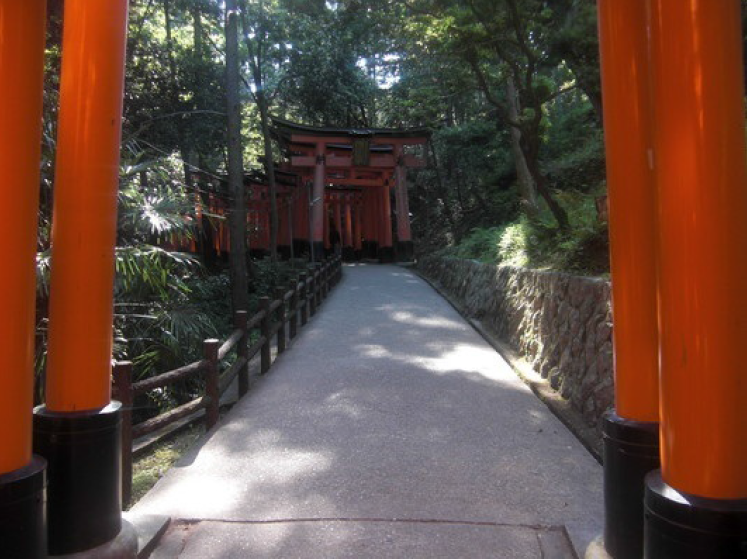
Kumataka -sha mound ( stone tower )

As you climb the stairs in front of Shin-ike, you will suddenly see countless shrines and torii gates in front of you.
This is a group of ritual stones called “Otsuka” at Mt. Inari.
The mounds stand like a terraced field on a mountain slope.
If you see the chaotic landscape, you will be surprised and stop your feet. The scenery is so unique.
I don’t want to go in at night because it’s creepy.

Shin-ike (Kodama-ga-ike)

After passing through the mound and climbing the stairs, a large pond spreads in front of you.
The name of the pond is called Shin-ike, and there is a reputable Kumataka-sha shrine on the side of the pond.
Shin-ike is also known as Kodama-ga-ike. Kodama means echo.
When someone asks you, first clap at the pond. And if you look for the direction where the echo came back, you can get clues of the person asking.
Kumataka-sha

The first shrine you encounter on the Mountain Trail is Kumataka-sha shrine.
The size of Kumataka-sha is the largest in Mt.Inari. Many people come to wish for a game and business prosperity.
In front of Kumataka-sha, there is a store called “Takeya”, founded in 1757, where you can buy candles and torii dedicated to Kumataka-sha.
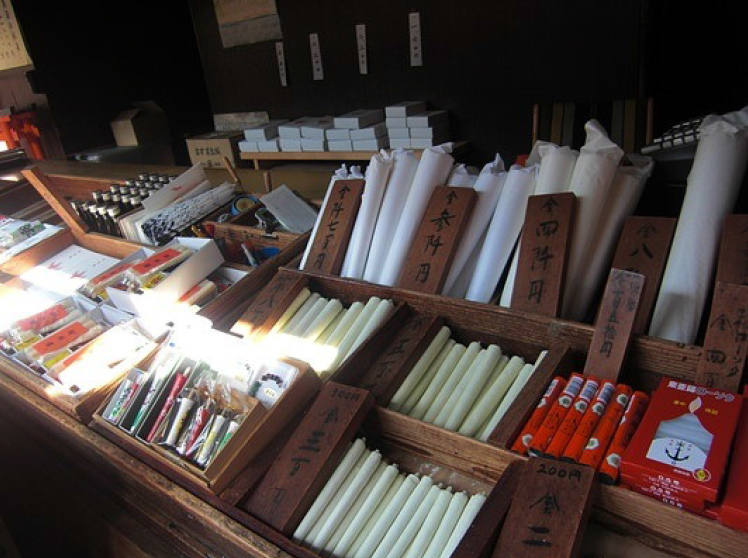
Kumataka-sha is one of the most popular spots in Mt. Inari because of its business prosperity.

It is a Shin-ike from Kumataka-sha.


This is where the torii purchased at store “Takeya” is dedicated.
There are many torii gates displaying the wishes of the people.
Approach from Kumataka-sha to Mitsutsuji
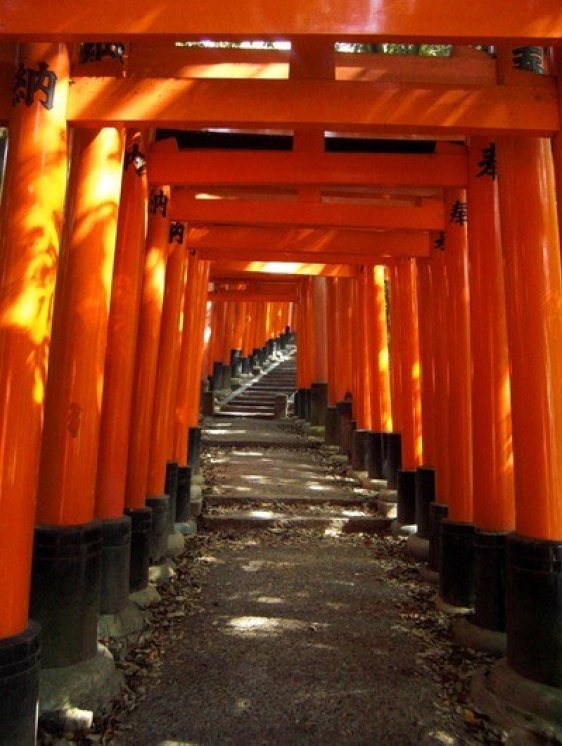
Proceed further from Kumataka-sha.
The approach road has a steep slope. The heart rate rises with the continuous climbing stairs.
However, when you look sideways, you can see the beautiful green and orange contrast between the torii gate and the fresh green light.
Mitsu-tsuji

After climbing the stairs, you will arrive at a T-junction.
It is called Mitsuji and its name means that the road is divided into three directions.
If you go to the right, it is the approach to the mountain trail that leads to Yotsutsuji.
The left hand leads to Urasando (Back approach) and you can return to the foot of Mt. Inari.

Mitama-tei
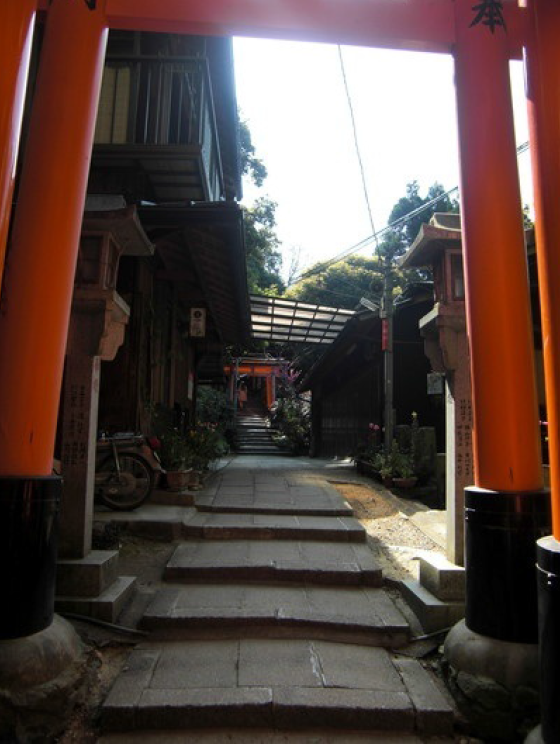
As you go from Mitsujitsu to the back and pass through the torii gate, you can suddenly find a place with a nostalgic landscape like a downtown area.
So far we have traveled on a long approach, surrounded by green and red torii gates, where the torii gates disappear and the sacred barrier breaks. Shops are lined up along the road, creating a lively landscape.
Here is a tea house called Mitama-tei.
You can heal the tired body, drink tea, and have a snack.

On the mountain trail, near a small shrine, there are these tea houses where you can drink tea and juice. Of course, you can also have meals such as Kitsune-udon and soba. Kitsune-Udon is famous in Mt. Inari. Kitsune means a fox.

This is a photo of July 2019. I visited in the morning, so the store may not have been opened yet.
Recently there are more foreign tourists than Japanese tourists
Kyo-ya, Enoki-sya

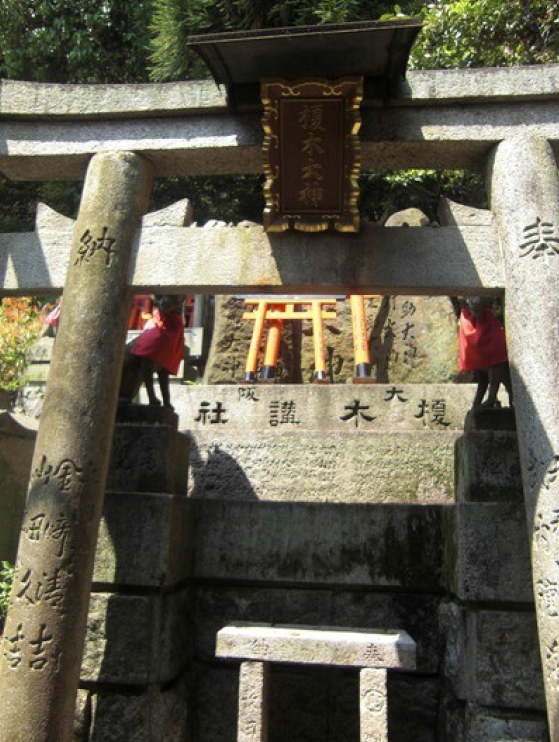
As soon as you go up the stairs from Mitama-tei, there is a tea house called Kyoya.
This restaurant has a large parlor, where you can get Kitsune-udon, nishin-soba, and inari- sushi. Enoki-sha is in front of Kyoya.
Inari-sushi means a sushi wrapped in fried Tofu skin.This is a very recommended sushi because it is very delicious.
 | 価格:840円 |
hyo-tei
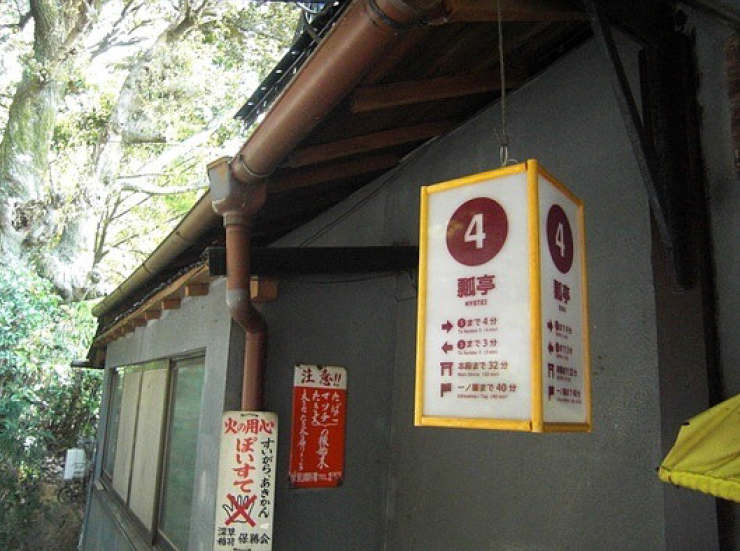
When you climb the stairs from Enoki-sha, you will see an unusual tea house called “Hyo-tei” on your right.
Daimatsu-sha


Daimatsu-sha is enshrined in the form of a giant “gourd”.
That is why the tea house in front of you is called “Hyo-tei”. Because “Hyo” means gourd.
Santoku-tei, Santoku-sha

As you go up the stairs, you will see “Santoku-tei” on your right and “Santoku-sha” on your left.
Santoku-sha has a splendid shrine structure. By praying to this shrine, you are granted the three powers of Inari God (wisdom, kindness, and bravery).

Distant view from in front of Yotsu-tsuji
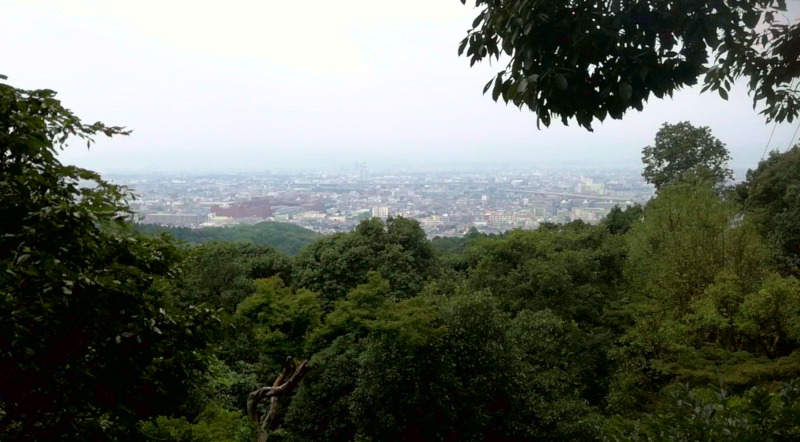
In front of Yotsu-tsuji, there is a landing where you can see the Fushimi area of Kyoto city. From here you can see Ryukoku University and the highway in Fushimi Ward.
Stairs to Yotsu-tsuji

Steep stairs follow.
Let’s climb step by step without getting upset.
Turn left and pass through the torii gate and you will find Yotsu-tsuji, a resting place and observatory with a good view.
This is the end of the second introduction. Continue to the third introduction.
Your good actions can keep Kyoto beautiful.
Recently, many foreign tourists have visited Kyoto. Kyoto citizens are in trouble because of their poor manners.
Japanese tourist spots are not just for you. If you like Kyoto , please keep it clean and follow Japanese manners so that many people can have a good time in Kyoto.

